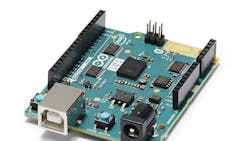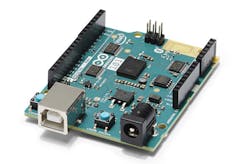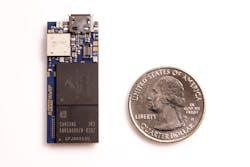This file type includes high-resolution graphics and schematics when applicable.
The Internet of Things (IoT) can exist with conventional microcontrollers and SoCs, but issues such as low power requirements and wireless support have pushed development of platforms designed for IoT applications. Hardware security support is now a requirement and forthcoming ARMv8-M microcontrollers will be the new benchmark for security (see “New ARM v8 Architecture for Microcontrollers”). Specialized coprocessor support is also common from sensor integration and neural networks.
Many of the coprocessors found on IoT-oriented platforms are designed to do more, often targeted, processing using less power than using software alone on a conventional platform. One example is Intel’s Curie based around a 32-bit Quark SoC. It incorporates a 32-bit DSP for sensor fusion support as well as a 128-neuron pattern matching accelerator. The neural network is supported by General Vision’s CurieNeurons library. The module has Bluetooth Low Energy (BLE) support as well as a six-axis accelerometer and gyroscope. The Intel Curie is the compute engine for the Arduino 101 board (Fig. 1). The neural net support is also available in a standalone chip from General Vision (see “Neural Net Chip Enables Recognition for Micros”).
IoT platforms typically incorporate wireless support of one sort or another as well as sensor fusion support normally done by a separate, low-power processor that runs independent of the primary processor. As noted, hardware security support is becoming more important and integrated, but there are alternatives.
For example, Microchip’s 3-mm by 2-mm AWS-ECC508 chip is preconfigured to provide mutual authentication with Amazon Web Services IoT (AWS IoT). There are a number of I2C-based security chips available, but this one is already registered for development work and it can be customized to handle the product production process. The chip is linked to a host processor, which runs software from the AWS Software Development Kit (SDK). The chip’s keys are already set up to work with AWS.
Sometimes a single-chip solution is not always possible or preferred, even in a mobile IoT environment. Developers can create something from scratch and it often makes sense if production quantities runs into the millions, but modules are often a good alternative for prototypes in lower quantities. Revolution Robotics’ Warp_0x01 module (Fig. 2) is an open-source hardware platform that fits the bill (see “Tiny Modules Target IoT Applications”). It is based on NXP’s low-power i.MX6 SoloLite with an ARM Cortex-A9 core. The module also contains 512 MBs of LPDDR2 memory and a 4-GB eMMC flash module. It also has 802.11b/g/n WiFi and Bluetooth Low Energy 4.0 wireless support. The i.MX6 has access to a six-axis accelerometer and magnetometer sensor.
IoT chips still need a lot of software to link them to nearby IoT devices or the cloud. Still, having the right low-power hardware makes a developer’s job much easier.
About the Author
William G. Wong
Senior Content Director - Electronic Design and Microwaves & RF
I am Editor of Electronic Design focusing on embedded, software, and systems. As Senior Content Director, I also manage Microwaves & RF and I work with a great team of editors to provide engineers, programmers, developers and technical managers with interesting and useful articles and videos on a regular basis. Check out our free newsletters to see the latest content.
You can send press releases for new products for possible coverage on the website. I am also interested in receiving contributed articles for publishing on our website. Use our template and send to me along with a signed release form.
Check out my blog, AltEmbedded on Electronic Design, as well as his latest articles on this site that are listed below.
You can visit my social media via these links:
- AltEmbedded on Electronic Design
- Bill Wong on Facebook
- @AltEmbedded on Twitter
- Bill Wong on LinkedIn
I earned a Bachelor of Electrical Engineering at the Georgia Institute of Technology and a Masters in Computer Science from Rutgers University. I still do a bit of programming using everything from C and C++ to Rust and Ada/SPARK. I do a bit of PHP programming for Drupal websites. I have posted a few Drupal modules.
I still get a hand on software and electronic hardware. Some of this can be found on our Kit Close-Up video series. You can also see me on many of our TechXchange Talk videos. I am interested in a range of projects from robotics to artificial intelligence.





